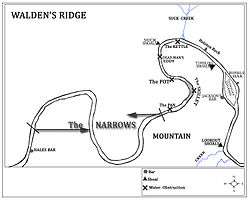Tennessee River Gorge

The Tennessee River Gorge is a 26-mile (42 km) canyon formed by the Tennessee River once known as Cash Canyon. It is the fourth largest river gorge in the Eastern United States. The gorge is cut into the Cumberland Plateau as the river winds its way into Alabama from Tennessee. The Tennessee River Gorge is home to endangered species like the bald eagle and the mountain skullcap. Many archaeological sites have been discovered in the gorge that show that people have been dwelling in the canyon for at least 10,000 years.
Prior to the completion of Hales Bar Dam in 1913 and the subsequent raising of the water-level, the stretch of the Tennessee River flowing through the Gorge was notorious for its navigational hazards, whirlpools, eddies, shoals, and one huge rock. Beginning with Williams' Island and the sandbars on either side of that, these obstructions included Tumbling Shoals, the Holston Rock, the Kettle, the Suck Shoals, the Deadman’s Eddy, the Pot, the Skillet, the Pan, and, finally, the ten-mile Narrows, ending with Hale's Bar. Of these, the Kettle, or the Suck as it is better known, at the mouth of Suck Creek is the most infamous, drawing notice from even Thomas Jefferson, who had never been anywhere near the area and lending its name to the entire stretch of treacherous river, which is also known locally by the name Cash Canyon.

Image gallery
-

Signal Point Looking East
-

Signal Point Looking West
-

Elder Mountain
External links
Coordinates: 35°01′41″N 85°32′42″W / 35.028°N 85.545°W